#pulsar timing array
Text
Science influencers keep saying "the universe is humming" because of the pulsar timing array just discovered the Gravitational Wave Background of low frequency waves, when it's objectively better to say that the universe is wobbling like freestanding custard or flan
105 notes
·
View notes
Text
Man. Space is wild. It’s so so so big and we kinda just. Made something that uses STARS to SEE. AND ITS CALLED THE FUCKING PTA? AM I A DISGRUNTLED PARENT GOING TO A SHITTY PTA MEETING? BUT ITS ABOUT PULSARS ND SHIT???
#space#deep space#pulsar#pulsar timing array#PTA#gravity#SPACE IS SO COOL THO LIKE?#I LOVE IT SO MUCH
0 notes
Text
new physics just dropped
I’m no scientist but the space news is hype af. In short, we’ve got a new method of observing the universe using gravity from monitoring the movement of pulsars (the result of super massive black holes colliding) over the past 15 years. Until now, the standard for understanding the universe has been by looking at photons, so this will open up a whole new method to view things from.
Good article: https://www.scientificamerican.com/article/galaxy-size-gravitational-wave-detector-hints-at-exotic-physics/
Digestible Twitter links: (thankyou Hank)
https://twitter.com/hankgreen/status/1673752025975394305
https://twitter.com/hankgreen/status/1674227289020850177?s=20
https://twitter.com/chrislintott/status/1674207116263931915
#science#science news#space#space news#gravity#pulsar timing arrays#hank green#galaxy#black holes#dark matter#exotic physics
1 note
·
View note
Text
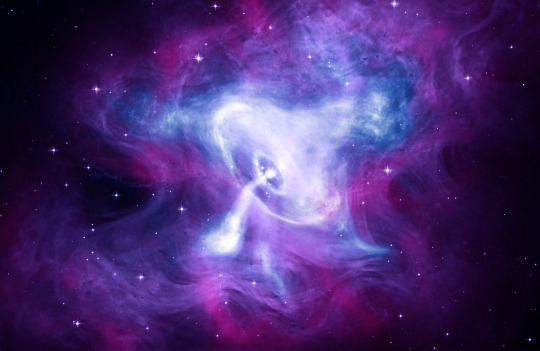
Navigating Deep Space by Starlight
On August 6, 1967, astrophysicist Jocelyn Bell Burnell noticed a blip in her radio telescope data. And then another. Eventually, Bell Burnell figured out that these blips, or pulses, were not from people or machines.

The blips were constant. There was something in space that was pulsing in a regular pattern, and Bell Burnell figured out that it was a pulsar: a rapidly spinning neutron star emitting beams of light. Neutron stars are superdense objects created when a massive star dies. Not only are they dense, but neutron stars can also spin really fast! Every star we observe spins, and due to a property called angular momentum, as a collapsing star gets smaller and denser, it spins faster. It’s like how ice skaters spin faster as they bring their arms closer to their bodies and make the space that they take up smaller.
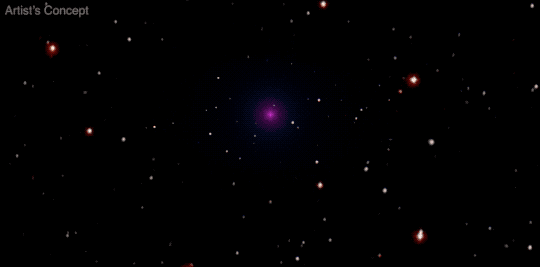
The pulses of light coming from these whirling stars are like the beacons spinning at the tops of lighthouses that help sailors safely approach the shore. As the pulsar spins, beams of radio waves (and other types of light) are swept out into the universe with each turn. The light appears and disappears from our view each time the star rotates.

After decades of studying pulsars, astronomers wondered—could they serve as cosmic beacons to help future space explorers navigate the universe? To see if it could work, scientists needed to do some testing!
First, it was important to gather more data. NASA’s NICER, or Neutron star Interior Composition Explorer, is a telescope that was installed aboard the International Space Station in 2017. Its goal is to find out things about neutron stars like their sizes and densities, using an array of 56 special X-ray concentrators and sensitive detectors to capture and measure pulsars’ light.

But how can we use these X-ray pulses as navigational tools? Enter SEXTANT, or Station Explorer for X-ray Timing and Navigation Technology. If NICER was your phone, SEXTANT would be like an app on it.
During the first few years of NICER’s observations, SEXTANT created an on-board navigation system using NICER’s pulsar data. It worked by measuring the consistent timing between each pulsar’s pulses to map a set of cosmic beacons.
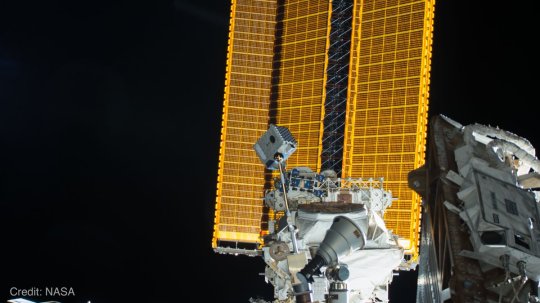
When calculating position or location, extremely accurate timekeeping is essential. We usually rely on atomic clocks, which use the predictable fluctuations of atoms to tick away the seconds. These atomic clocks can be located on the ground or in space, like the ones on GPS satellites. However, our GPS system only works on or close to Earth, and onboard atomic clocks can be expensive and heavy. Using pulsar observations instead could give us free and reliable “clocks” for navigation. During its experiment, SEXTANT was able to successfully determine the space station’s orbital position!

We can calculate distances using the time taken for a signal to travel between two objects to determine a spacecraft’s approximate location relative to those objects. However, we would need to observe more pulsars to pinpoint a more exact location of a spacecraft. As SEXTANT gathered signals from multiple pulsars, it could more accurately derive its position in space.
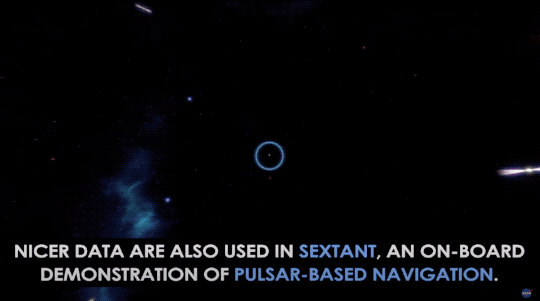
So, imagine you are an astronaut on a lengthy journey to the outer solar system. You could use the technology developed by SEXTANT to help plot your course. Since pulsars are reliable and consistent in their spins, you wouldn’t need Wi-Fi or cell service to figure out where you were in relation to your destination. The pulsar-based navigation data could even help you figure out your ETA!
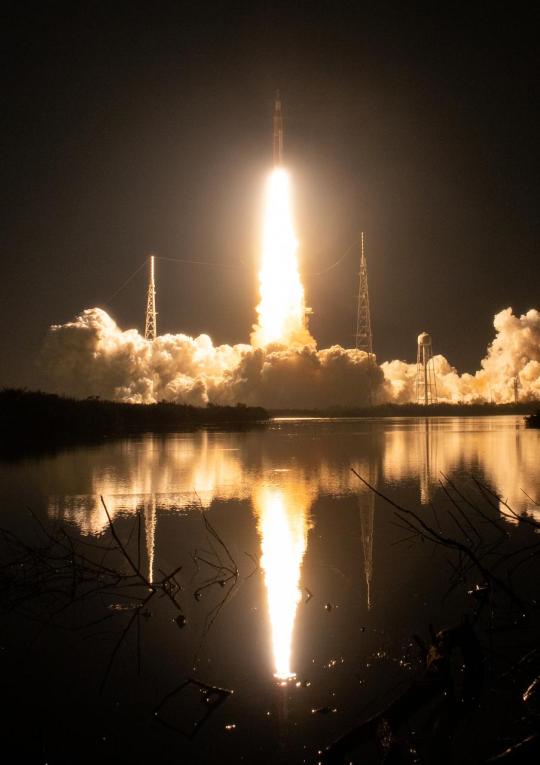
None of these missions or experiments would be possible without Jocelyn Bell Burnell’s keen eye for an odd spot in her radio data decades ago, which set the stage for the idea to use spinning neutron stars as a celestial GPS. Her contribution to the field of astrophysics laid the groundwork for research benefitting the people of the future, who yearn to sail amongst the stars.
Keep up with the latest NICER news by following NASA Universe on X and Facebook and check out the mission’s website. For more on space navigation, follow @NASASCaN on X or visit NASA’s Space Communications and Navigation website.
Make sure to follow us on Tumblr for your regular dose of space!
#NASA#pulsar#Jocelyn Bell Burnell#spaceblr#space#star#neutron star#deep space#telescope#navigation#universe#astronomy#science
4K notes
·
View notes
Text
hello! i've got some GROUNDBREAKING space news for you!
scientists have uncovered evidence for a gravitational wave background (GWB) in our universe, and the way they went about it is fascinating.
To fully understand what's going on here, we need to go into a bit of background information.
First of all: what are gravitational waves? gravitational waves are often called 'ripples' in spacetime, often caused by extremely energetic processes such as black holes colliding, or two neutron stars orbiting each other closely.
So, how did scientists figure this out? They used 67 pulsars (known as the Pulsar Timing Array) throughout the Milky Way, practically creating a galaxy-sized telescope in order to study this.
Pulsars are the extremely dense cores of massive stars, left over after they go supernova. These are fascinating on their own, but for this project, they had an essential feature: Pulsars rapidly rotate (think up to hundreds of rotations per second), spewing radiation out in pulses from their magnetic poles. For some pulsars, these radiation jets cross Earth's line of sight, and we get incredibly constant bursts of radio signals, which can be catalogued and used as a sort of standard, universal clock.
Here is a link to a gif showing the rotation of a pulsar. Please be warned for flashing and eyestrain.
For 15 years, a team of astronomers working for the North American Nanohertz Observatory for Gravitational Waves (NANOGrav), used radio telescopes around the globe to track minuscule changes in the signal patterns from pulsars. The changes they found are due to the slight movement of spacetime between us and the pulsars, stretching and compressing the paths of their radio waves as extremely low frequency gravitational waves pass through the universe (yes, that includes you. your atoms, as well as the atoms making up everything around you, are very slowly shifting position, dancing along to the heartbeat of the universe).
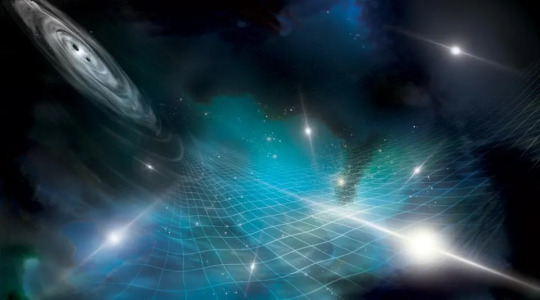
At the moment, scientists are still debating what could have caused this gravitational wave background, but some there are some leading theories: the GWB could be caused by trillions of binary black hole systems (black holes orbiting each other) throughout the universe. It could also be due to cosmic inflation, or even the big bang itself. Scientists just don't know yet, but the opportunities this discovery opens up are incredible.
The knowledge of the GWB could help us better understand the formation of early galaxies, or even help us understand the origin of the universe.
#aspaceinthecosmos#space#astronomy#outer space#just jupiter#astrophysics#gravity#gravitational waves#physics#pulsars#black holes#neutron stars#the universe#LIGO
597 notes
·
View notes
Text
A leap of faith and physics
We thought for a civilization to form, one needed liquid water, a stable planet with a hot core, and tardium crystals. Apparently, this is not so.
Because we just received a vibromessage over the tachyon network from an unknown source.
Which in itself would not be too unusual. Plenty of newly realized civilizations figure out how to configure tardium to send tachyon messages across isospace. Hoping someone will answer. We always do. It always takes some time to go from simple repeating messages to understanding one another. Most civilizations don't come up with the galactic standard modulation on their own. Nor do we know their form of communication all that well, language, culture, all of that.
First contact is always a lengthy affair, until the new species is integrated into the intergalactic community. Then follows the exchange of knowledge and culture, the setting up of historical archives and sharing of starcharts. Since light travels only at luxionic speed, the charts provide a valuable look at the past. Once the new civilization has been caught up to date, things tend to settle. Updates are fewer and far in between, and culture tends to somewhat homogenize. Not completely, of course, as everyone has different living circumstances, but with all the exchange between us, some settling is bound to happen.
But we know where tardium reserves are, have felt the reverb of our scans, we know where civilizations could potentially pop up. The message we received was unusual not because its source was unknown, but because it came from a sector without any sufficient tardium deposits.
That... shouldn't even be possible!
The signal is also a bit noisy. Strange. Usually, the bigger the tardium array, the more self-stabilization should occurr. And for interstellar communication, you tend to need quite large arrays. So then why was there so much noise?
It was clearly a signal, and according to the triangulators, it came from the outer third of a dark spiral galaxy. We call them that, since they were never really observed, at least not with any isocartography. We only know they're there due to shared star charts. No idea what's going on with them at the current isotime. We can't know, without any tardium resonance to pick up.
Anyway, of course we answered. Their signal had been prime numbers, if we demodulated it correctly, followed by things we couldn't really make sense of. It was standard practice to begin communications with mathematics, and fundamental harmonics. It's strange that they did that right away, but not unheard of. We sent back primes, and then a couple of playful harmonics. Music. What we received back was weird, because we thought it was music, but it wasn't.
It turned out to be a starchart, and not just any kind. Pulsars. We sent back a chart of their galaxy, as reconstructed from several older starcharts. Then, we waited for their answer. And waited. And waited. An entire solar cycle (of our species) later, we finally got another answer.
And it just would not stop. We recognized it was a series of images, or rather, rapid successions of images, together with harmonics on a different band as well. This was video! The footage depicted a bipedal species, with symbolics next to different features. The images cycled through different body parts, with different descryptions. We had a really hard time catching and saving all the data, a task which had to be offloaded to the communal computation grid, as our own planet simply did not have the capacity to do it alone. This should have tipped us off to what we were going to be dealing with, but it didn't.
We continued, almost business as usual, just a fair bit faster. Then objects were being shown, often together with the bipedals, and their corresponding glyphics were depicted right next to them. Also, each image was accompanied by a sound file. They really made learning their language easy for us. We learned that they called themselves Humans, and their home was Earth, a planet orbiting a yellow star. They were a surface dwelling species! Those are pretty rare, as most can not survive the exposure to open space for some reason. We then sent back images and glyphics of our own, matching them in their intent. We sent images of life forms, images of our own body parts, images of objects and always accompanied by isostandard glyphics.
Usually, once communication has come to a basic understanding, the exchange of culture would begin.
But the Humans had started out with primes and starcharts, so of course, their next communication wasn't about culture. We... honestly didn't know what exactly it was, for a while. Until some of the mathematicians from across the network found patterns. They were sharing mathematics with us!
Eager to help, we sent back entire databases full of insights. They requested more soon. So we sent more. And more. And more. We wondered how they could even store all that we sent them. We asked. They sent back something we didn't understand. We hoped the mathematicians could figure it out, but nope.
Eventually, we sent steam engine configurations, as well as the corresponding heating and shunting tardion-arrays used to power them. They sent back their own designs for steam engines. And other engines that seemed similar, but shoudn't work with steam. The machine configurations, piston layouts and such, were fairly primitive. As was to be expected from a new species. But they never sent us schematics of their heating or shunting arrays. When we asked how they kept things cool without shunting arrays, they sent back another steam engine. But, when we called it that, they corrected us. What they had shown us was a heat pump. They used the opposite effect, instead of creating movement from a temperature difference, they created a temperature difference from movement. We asked them why they wouldn't just use shunting arrays. They asked what those were.
And this is how we found out why they were in dark space. Why their signal was so noisy. And why they had never depicted heating or shunting arrays in their schematics.
They had practically no tardium. They simply did not have enough of it to make arrays, as we thought all civilizations do. The largest piece of tardium they had was the centerpiece of a gigantic machine. It was about the size of a human "nail", which is a vestigial claw originally used for superior grip on one of the native plant species of their planet.
We did not know how to respond. We could not comprehend how a civilization could form without tardium crystals. They asked us if we knew where more could be found, preferably near them. We didn't understand what they meant. Then they asked us how to locate reserves. We gave them the modulations that we use to scan for the crystals' tachyon resonance.
They thanked us, and ceased their questions. Then, communication became choppy. Only occasionally would we receive an exchange of culture. Their questions about mathematics and tardium crystals ceased.
---------------------
When we first received back an answer from the deep space tachyon dish, we were extatic. And shocked. And kind of in disbelief. Nobody had really known if it would work. Still, everyone in the control room agreed that we should make sure it was really a signal, before we dropped that bombshell to the public.
We focused a couple more dyson collectors onto the dish, and changed the signal. Instead of primes and harmonics, this time, we encoded the pulsar chart, multiple times, in every encoding we could think of, and sent them all.
Only a few hours later, we received another signal from the previous location. The encoding was our own, easily recognized. With shaky hands, i pressed the 'open image file' button.
When i was greeted by a picture of the Milky Way, everyone in the room lost their collective shit.
"Holy Fuck!" "Oh my god." Someone fainted. Multiple people cried. Nobody minded any of that.
~~~
The prime administrator creased her brow. The direct line was ringing. This better be important. "Hello? Prime administrator here." From the other end, she could hear someone suppressing tears, and whimpering: "Tachyon dish project operator here. We... we."
"Everything ok over there?", she asked. What could possibly have happened that had the scientist crying? Was there an accident with the dyson swarm or something? Did people die? No, she trusted the operator of that experiment to not call unless it mattered to the entire human race.
A wet chuckle. "Better than ok. Maam? We... We're not alone."
Not alone? What does that...? Oh. OH! oh
"Are.. you sure?" Dammit. Now even her own voice was shaking.
"We sent a pulsar chart and got a beautiful image of the Milky Way back, in the same image file type. Pretty sure at this point."
~~~
The following year was downright insane. The mere confirmation that we weren't alone in the universe spurred us all on. Artists did their best to show all sides of us, scientists got together to determine what questions we should ask, even the long obsolete military awakened from its slumber, churning out tactical analyses of possible tachyon based weaponry, and how to defend against it.
Some people were panicking, others in denial, but most relished the opportunities that might open up.
Policies were made, on how to handle aliens that would come to the solar system. Tachyon mechanics, an until now unproven theory, made leaps and bounds, scientists working as hard as they could to understand it better.
The dyson collectors were turned to multiple new research projects, powering large machines that channeled vibrations into the tiny crystals we had found to pick up on tachyon vibrations. The largest one that we had discovered while asteroid mining was still in the communication dish, but the smaller shrapnel, a couple millimeters in size at the most, were being utilized.
Eventually, after a year was up, communications resumed. The linguists sent data, and worked closely with the astronomers that had made the initial transmissions. We also received back data, and the scientific community devoured every piece of information. We learned their language as fast as we could.
But our requests for the sharing of scientific knowledge appeared to fall on deaf ears. Whenever we sent natural constants, or physical laws, we got nothing back. Well, almost. Our prodding did yield one answer: How to locate the crystals. Which were apparently common? Though our scans painted a different picture. We did have some scattered about the asteroid belt, yes. But the largest one we detected was only 3cm in diameter. A little bigger than the one in the communication dish, sure, but not that much.
We came to accept this, figuring that maybe there was some kind of prime directive that forbade the sharing of further technology. Actually, perhaps we leaned a bit too far into our Star Trek analogy. Because most of us would not get it out of our heads to try to build a warp drive. Well, not really a spacetime bending drive, but something that could go faster than light. Because, obviously, thanks to our discovery, we now knew that while the speed of light may be finite, the speed of information was not.
-----------------------------
After ten cycles of cultural exchange, the humans sent a request for isocoordinates of the nearest known civilization to their own. This request kind of drowned in the noise, we didn't really think about it much, we just transmitted our coordinates. Turns out, the nearest ones were us, in what the Humans call the Andromeda Galaxy.
Shortly after the request, they went totally vibrosilent. We tried and tried to contact them, but to no avail. This, while tragic, was a reality of civilization, though. Extinction events could always happen. Sometimes the affected civilization would realize in advance and send a couple warnings, but nobody could help them from afar, of course. So that's what we figured happened to Humanity. Maybe their sun blew up, or they got knocked away from it by a passing object, anything could have happened.
Many cycles passed. I had aged, my once young and springy exoskeleton now wobbly and soft, though my mind was still sharp enough to crew a communications array.
None of us were prepared for the schockwave resonating through our sensor grids. Multiple arrays straight up shattered. Luckily, as big as they were, there was nobody close to them, so no deaths. What the rest of them picked up though made no sense. We could determine there was a pulse, but no normal communication had that level of power, nor resonance.
Then, half a planetary rotation later, there was a new luminance in the sky. We were about to renew our arrays and update our starchart, when the light source moved. Toward the planet.
What?
And then, my assigned communications array resonated.
"This is the Human vessel Enterprise, calling anyone on the planet. Can you read us?" the crystal sang in choppy English, the language of the Humans. The ones we thought were extinct.
I scuttled to my post at the resonator, tuning it to reply:
"This is communications, we read you, but i don't understand? We are recovering from an unprecedented resonance pulse that shattered multiple arrays, sorry if the modulation is a bit off."
The answer was swift: "Sorry about that, our engines are a bit out of tune at this point. That pulse might have been us. Glad to hear you all down there, is anyone injured?"
"Your engines? And uh. No, nobody injured."
"Yes our engines, again, we apologize for that. But glad to know everyone is alright.
Requesting permission to land on the surface."
This was a momentous occasion, which i didn't realize until later on. The entire tachyon network would eventually refer to this exact communication as a reference time. This exact moment would come to be known as 0:0 PFJ
0 Cycles and 0 rotations Past First Jump.
The only thing i remember is absently giving permission, not quite understanding what exactly they were requesting here. If i had, i would have convened with the councils beforehand.
Then, the cave began to shake. It wasn't coming from any of the arrays. It was coming from the surface.
~~~
They. They were here. The Humans were here. On the surface. Of. Of our planet. What? How?!
Most importantly, why?!
Then i remembered the stories about their exploration of the surface of their own planet. How they had sent people to their poles, despite their biology not being fit to survive there. And several did die! How they climed mountains. Made pressurized vessels to dive below the surface of their open ocean. We asked them why. They told us.
I realized at that moment, not how they were here. But why.
"Because we could, and no human had been there before," they had answered back then.
363 notes
·
View notes
Text
ASTRONOMERS HAVE DETECTED A NEW GRAVITATIONAL-WAVE??
Blog#316
Saturday, July 22nd, 2023
Welcome back,
After nearly two decades of listening, astronomers are finally starting to “hear” the rumbles of gravitational waves they believe emanate from the behemoths of our universe: supermassive black holes.
The result comes from a National Science Foundation–sponsored initiative known as the North American Nanohertz Observatory for Gravitational Waves (NANOGrav).

Since 2004 NANOGrav has monitored metronomelike flashes of light from a Milky Way–spanning network of dead stars known as pulsars. Forged from the hearts of exploding massive stars, these city-size orbs weigh as much as an entire sun and can spin thousands of times per second. This makes them remarkably accurate timekeepers—and ideal sentinels for the especially large ripples in spacetime predicted to emerge from merging supermassive black holes.
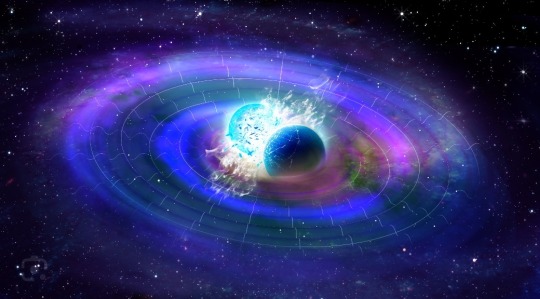
Such gravitational waves are distinct from the kinds that were previously reported from the Laser Interferometer Gravitational-Wave Observatory (LIGO) and other Earth-based detectors. For one thing, the waves spotted via pulsars wouldn’t all be traceable to individual merger events: they would form the so-called gravitational-wave background, the ambient rustling of spacetime built up from cumulative mergers throughout the cosmos.
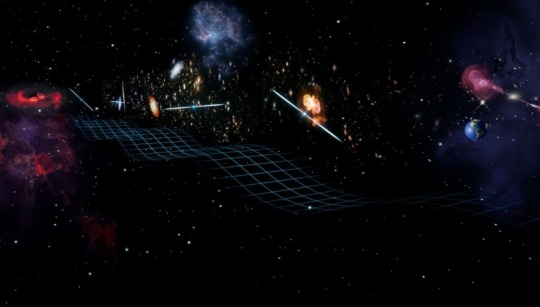
Another important distinction is that in their crest-to-trough span, each of these waves should be approximately the size of our solar system—which counterintuitively makes them much harder to detect. Washing over pulsar-strewn space, these gargantuan swells in spacetime could betray their presence via minuscule offsets to the dead stars’ spins, allowing observers to glimpse them through painstaking measurements. In a collection of five papers released today, that is essentially what NANOGrav claims to have done.

“It’s incredibly exciting because we think we’re starting to open up this new window on the gravitational-wave universe,” says Sarah Vigeland, an astrophysicist at the University of Wisconsin–Milwaukee and a member of NANOGrav.
(The collaboration’s work to date hasn’t quite met the statistical gold standard of how physicists evaluate the robustness of a finding.)

(So for now, scientists working on the project are modestly claiming “evidence for” the gravitational-wave background, not a full-fledged detection. But they’re confident that milestone will come with additional observations.)

NANOGrav is just one of several different pulsar timing array projects underway around the globe. All these endeavors follow the same basic blueprint: they use radio telescopes to monitor dozens of superpredictable pulsars for years on end to catch tiny variations in their rhythmic spinning.
Originally published on scientificamerican-com
COMING UP!!
(Wednesday, July 26th, 2023)
"WHAT IS STAR NIBIRU??"
#astronomy#outer space#alternate universe#astrophysics#universe#spacecraft#white universe#space#parallel universe#astrophotography
224 notes
·
View notes
Photo
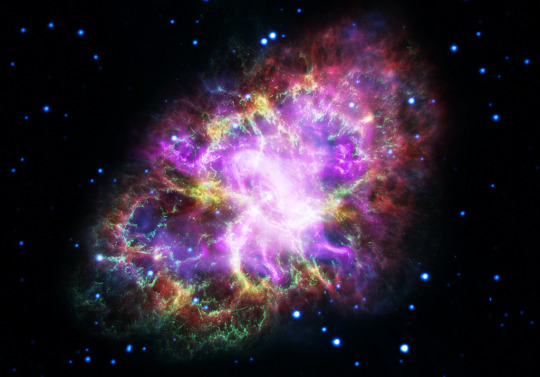
The Multiwavelength Crab : The Crab Nebula is cataloged as M1, the first object on Charles Messier's famous list of things which are not comets. In fact, the Crab is now known to be a supernova remnant, expanding debris from massive star's death explosion, witnessed on planet Earth in 1054 AD. This brave new image offers a 21st century view of the Crab Nebula by presenting image data from across the electromagnetic spectrum as wavelengths of visible light. From space, Chandra (X-ray) XMM-Newton (ultraviolet), Hubble (visible), and Spitzer (infrared), data are in purple, blue, green, and yellow hues. From the ground, Very Large Array radio wavelength data is shown in red. One of the most exotic objects known to modern astronomers, the Crab Pulsar, a neutron star spinning 30 times a second, is the bright spot near picture center. Like a cosmic dynamo, this collapsed remnant of the stellar core powers the Crab's emission across the electromagnetic spectrum. Spanning about 12 light-years, the Crab Nebula is 6,500 light-years away in the constellation Taurus. via NASA
794 notes
·
View notes
Text
@forgivenpunishment
He reaches out.
Seven hundred times a second, he reaches out—pulsar-fast spinning bright crushed under his own gravity, he reaches out, invisible rays like a lighthouse through a vacuum universe.
He reaches out in the cold and the dark and the vast emptiness, piercing the ripples folded in on themselves in a curling fractal.
Nothing answers until it does; it is only half-aware, though some parts of it are conscious. Complex. Born to improvise, to feel.
It's funny in a maybe not-funny way how this particular type of sleep is called REM. Rapid Eye Movement, sure, but—
People. People he's lost. People he's held onto. People who, as long as Vash remembers, will not die. Not completely. Not wholly. And maybe it's unfair to hold on like this, but who is he tormenting but himself?
A moment of respite, a beat of sweetness, it aches, it burns, it's wonderful, lives and impressions intertwined. They are here, wherever here is; they are arrayed in a bed with sheets and pillows strewn in the passion of roughhousing and reunion.
Light slants in through the windows. Starlight, crystalline blue on the green of Home's trees, memories of a geo-plant mingled with recollections of a hotel in some quaint and quiet town on the road to somewhere.
It works. He's become more adept at this, at lucidity. Nevermind the ripple of watery distortion he cannot control, cannot afford to draw attention to lest it all collapse.
"It's amazing, there are so many possibilities, and you—you're doing so much good," Vash whispers between the blooms of warm, full kisses, gathering Wolfwood's hands to the center of his chest.
Beat, heartbeat. He cannot bring himself to ask. That would shatter it. This connection. This fragile space. He cannot interrupt his Nicholas' life, flourishing in company, making a difference.
Heartbeat, beat. I'm here. I'm here.
"—I'm so proud of you."
48 notes
·
View notes
Text
Before Pluto Changes Colors ~ 5 Jan 2024
Before Pluto Changes Colors ~ 5 Jan 2024, Philip Sedgwick
In the wee hours of 21 January (GMT) Pluto drops his Capricorn cloak and goes for something more of Aquarian airy style. There’s a big shift encroaching upon the collective consciousness as he pushes in the clutch for a better gear ratio. Slowly, over the next months, those things seemingly doused in impossibility begin to make more sense and options for resolution appear.

On the 15th to 16th of January, depending upon where in the world you are located, three interesting transits appear that include two dwarf planets and a centaur. Closer inspection might just reveal something new, previously not considered, and within the theme of Pluto changing signs, open an entirely new spectrum for consideration.
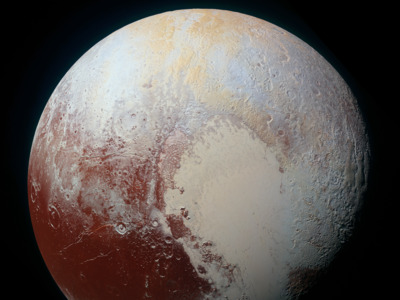
Pluto Close-Up, Courtesy NASA
The massively ringed one, Saturn, joins Gonggong in Pisces. Here alternative perspectives organically evolve when one savors any feeling of being stuck or immobilized. Saturn curiously will ask those not moving, “So, what are you going to do about this?” He deserves a good answer. An answer that contains practical objectives, a well-thought timeline, and a unique perspective. Back in the old days of pinball playing if a player jolted the machine for favor, the game could end in a tilt. With Saturn to Gonggong, a new tilt is required. Oblique points of view often align with long distance goals with sufficient parallax that one can actually see around the next bend and accurately determine what more may be required.
Saturn with Gonggong supports none of the tried and true that does not “grow corn,” “make hay” or produce a viable yield. Saturn in Pisces is not quick to condemn or criticize - actually here he can be quite empathetic. Those agreeing to get on with the getting on regardless of the tilted perspective receive kind support, thoughtful suggestions and an ample supply of grease . . . provided that Saturn senses the will to persist and persevere regardless of previous setbacks in life. Saturn kindly points out that what happened before happened before and with the new angle of approach toward life’s objectives, certainly results unlike any produced before may manifest... and it all seems to happen more swiftly if one can remain in their personalized creative zone.
Mars aligns with and passes by the centaur Pholus in Capricorn. These two currently navigate the thickest array of pulsars known. These pulsars jab new ideas and lofty concepts at ones cranium more regularly and faster than the speediest popcorn popper on Earth. Taking time to read the bumper sticker-like blips of consciousness reaching for your attention goes a long way in feeding creativity and locking onto inspired brainstorms.
Mars in Cap is exalted. Here, he is maximum in drive. He is impatient, eager and so keyed on getting going with projects that life essentials - food and drink - can be ignored. It’s never a good idea with a Mars transit to risk hangry. Pholus is all about food and drink. He insists that one make a ritual - a ceremony of eating food that is prepared properly. He asks if how you eat and drink and whatever other substances you may take in the interest of consciousness, totally and fully nurture your being. If a no, Pholus supports abrupt changes in diet, method of consumption, time taken for consumption, and quality of those things consumed. He wants all nurturing in life to be treated reverentially... as if it is a ceremony. In fact, he urges all to consider that every act taken in life is on the path of karma leading to dharma and thus a purposeful ritual. As such, all acts are meritorious (as in those things worth doing) and all efforts applied in life are indeed intended to fulfill the purposes of the soul.
Venus draws an exact bead on Ceres in Sagittarius at a degree in between the Great Attractor and the Galactic Center. They both draw from both galactic points. Very recently, both these goddesses aligned with a collection of potent black holes in Sagittarius. In this recent degree passage, thoughts on the table and up for discussion include:
Becoming an expert in all you do, or consulting only with those with impeccable wisdom when seeking advice, encouragement or critique.
Ensuring that all things done totally and completely align with ones beliefs. Consistency in creativity and consciousness.
Recognizing and revering every morsel of personal knowledge gained and committing to apply it fully in every life act, including thoughts, words and deeds.
Ceres and Venus advance upon and seek the wisdom of the Galactic Center. Together, they seek to understand the energy underscoring any life difficulty. With understanding, the energy can be shifted, and almost if by strategic pointing of a magician’s wand, the path can clear with insights applied. Ceres and Venus may be tempted to offer up critical - potentially judgmental life reviews. The recent transit to the Great Attractor presumably refreshed beliefs with the thought that new concepts deserve to be considered before dismissal. That everyone has a place in the plan. Inclusion is the easiest way to reduce resistance from others. And finally, everyone expects you to land those insights buzzing around inside their heads with a blazing and thoughtful information drop.
With these gravitationally significant galactic gizmos and their ongoing transits by planets, time and space warp as a matter of course. It’s simply what happens. What you realized today the world needs to know now takes some time for the collective to wrap around. While it may feel boring initially, reading from a journal what you documented six-months might do the trick. What you have assimilated... and come to understand... can be elucidated with greater ease that your latest high flying idea that still requires emotional adjustment on your part and a major dose of grounded applications to make sense of it.
While this may seem old hat, when utility is realized. progress is made, and previously stationary wheels move forward, know that your contribution of the galactic goodies you currently grok, works smoothing in resolving logjams without dynamite. Also, remember, to make the mundane move again and give it momentum, requires altering the energy that prevails as the substrate of stuck situations... not forcing, dominating or manipulating... simply unknotting that ball of energy.
These transits which precede Pluto donning his bright Aquarian duds by less than a week promote believing that things can work out more ideally than previously imagined. Really!
Can you think of a better way to start this brand spanking new year than with such thinking? Neither can Saturn, Pluto, Gonggong, Ceres, Pholus or Venus.
More soon...
This is a prime time to schedule a consultation or to load up with a reserve of consultations. A Galactic Report may shed new insights on life scenarios. You can also ask a question or two, or schedule a half-hour session if that’s what works better for you. The links below will get you started.
One Stop Shopping
Order Form
Astrological Texts
6 notes
·
View notes
Photo

Clock-like precision of pulsars opens new window for studying gravitational waves A team of European astronomers, along with Indian and Japanese colleagues, has reported evidence that strongly suggests the detection of ultra-low-frequency gravitational waves. Such waves, which have not previously been observed, probably originate from pairs of supermassive black holes at the center of merging galaxies. This discovery is the result of more than 25 years of observations with the most sensitive radio telescopes in Europe and India, including the Westerbork Synthesis Radio Telescope (WSRT) in the Netherlands. In doing so, they have opened a new window for studying gravitational waves, which can give astronomers a glimpse into the universe's best-kept secrets. The team's research has been published in a series of articles in the journal Astronomy & Astrophysics. The scientists on the team collaborate within the European Pulsar Timing Array (EPTA) and the Indian Pulsar Timing Array (InPTA). In EPTA, astronomers and theoretical physicists from more than ten institutions across Europe are using observations of very regular pulses from pulsars—highly magnetized rotating neutron stars—as a gravitational wave detector that is essentially the size of our Milky Way galaxy. From the Netherlands, astronomers from ASTRON and Radboud University are involved. It was also announced today that other teams from around the world have independently reported the same observations. Cosmological clocks The astronomically vast gravitational wave detector, which spans 25 specifically chosen pulsars scattered across the Milky Way, enables researchers to investigate gravitational waves at ultra-low frequencies with wavelengths of several light years. Such frequencies are impossible to observe with detectors such as LIGO and Virgo, which are limited to wavelengths of several kilometers. These ultra-low (nanohertz) frequencies provide the opportunity to observe unique sources and phenomena. Emma van der Wateren, Ph.D. student at the Netherlands Institute for Radio Astronomy ASTRON and Radboud University, explains, "Pulsars are fantastically accurate cosmological clocks. We use the changes in the extreme regularity of the 'ticking' of the clocks to detect the subtle stretching and compression of spacetime caused by gravitational waves." The gravitational waves reported in the current study are probably a sum of signals from a very large number of supermassive black holes orbiting each other very slowly. The researchers believe that the results provide a new window for exploring the universe. Astronomer Gemma Janssen (ASTRON, RU) says, "These ultra-low-frequency gravitational waves contain information about the universe's best-kept secrets. We still know little about the population of double black holes with huge masses—from millions to billions of times the mass of the sun—which form when galaxies merge." Coordinated observations "It has been quite an undertaking," added Ben Stappers of the Jodrell Bank Center for Astrophysics in the U.K. "These results are based on decades of coordinated observations with the five largest European radio telescopes: the Effelsberg radio telescope in Germany, the Lovell telescope at Jodrell Bank Observatory in the United Kingdom (UK), the Nançay radio telescope in France, the Sardinia radio telescope in Italy and the Westerbork Synthesis Radio Telescope in the Netherlands." To achieve additional sensitivity, the astronomers at the European telescopes made exactly simultaneous observations of the selected pulsars. They did this once per month, in addition to their regular observations. Observations from the EPTA were supplemented with data from the InPTA, resulting in an exceptionally sensitive dataset. Westerbork The Dutch contribution to the EPTA data is a dataset of pulsar observations made monthly for 16 years with the Westerbork telescope. Cees Bassa, scientist at ASTRON, explains, "The Westerbork dataset is unique because the signals were measured not only at lower frequencies, but also at the higher frequencies that are usually recorded. This dual-frequency approach enabled us to account for the effect of space weather, thus making the entire dataset more sensitive to gravitational wave signals." Besides observing pulsars, astronomers in the Netherlands were also behind the development of a new generation of pulsar instruments. These instruments are now used for pulsar observations at all European radio telescopes. Other teams The EPTA results were presented simultaneously with similar results from other teams spread around the world: the Australian, Chinese and North American Pulsar Timing Array collaborations (PPTA, CPTA and NANOGrav, respectively). "The independently obtained results are in agreement with each other, which makes us even more confident that this incipient signal is really coming from gravitational waves," Janssen said. Scientists from the main Pulsar Timing Arrays combine their datasets to generate the International Pulsar Timing Array. The aim is to expand and merge the PTA datasets, eventually creating a joint dataset. This will ultimately lead to new insights into the evolution of supermassive black holes and the enormous galaxies in which they formed. IMAGE....Gravitational waves are ripples in space-time, represented by the green grid, produced by accelerating bodies such as interacting supermassive black holes. These waves affect the time it takes for radio signals from pulsars to arrive at Earth. Credit: David Champion/NASA, JPL
15 notes
·
View notes
Text
https://www.washingtonpost.com/science/2023/06/28/gravitational-wave-background-nanograv
The mind-bending finding suggests that everything around us is constantly being roiled by low-frequency gravitational waves
By Joel Achenbach and
Victoria Jaggard
June 28, 2023 at 8:00 p.m. EDT
The very fabric of the cosmos is constantly being roiled and rumpled all around us, according to multiple international teams of scientists that have independently found compelling evidence for long-theorized space-time waves.
The claim that telescopes across the planet have seen signs of a “gravitational wave background” has sent a thrill through the astrophysics community, which has been buzzing for days in anticipation of the papers that were unveiled late Wednesday. The discovery seems to affirm an astounding implication of Albert Einstein’s general theory of relativity that until now has been far too subtle to detect.
In Einstein’s reimagined universe, space is not serenely empty, and time does not march smoothly forward. Instead, the powerful gravitational interactions of massive objects — including supermassive black holes — regularly ripple the fabric of space and time. The picture that emerges is a universe that looks like a choppy sea, churned by violent events that happened over the course of the past 13 billion-plus years.
The gravitational wave background, as described by the astrophysicists, does not put any torque on everyday human existence. There is not a weight-loss discovery in here somewhere. A burble of gravitational waves cannot explain why some days you feel out of sorts. But it does offer potential insight into the physical reality we all inhabit.
“What we measure is the Earth kind of moving in this sea. It’s bobbing around — and it’s not just bobbing up and down, its bobbing in all directions,” said Michael Lam, an astrophysicist at the SETI Institute and a member of the North American Nanohertz Observatory for Gravitational Waves (NANOGrav), a team largely based in North America. The NANOGrav team released the findings in five papers that were published Wednesday in the Astrophysical Journal Letters.
Teams in Europe, India, Australia and China also observed the phenomenon and planned to post their studies at the same time. The simultaneous release of papers from far-flung and competitive teams using similar methodology came only after some scientific diplomacy that ensured no group tried to scoop the rest of the astrophysical community.
“We’ve been on a mission for the last 15 years to find a low-pitch hum of gravitational waves resounding throughout the universe and washing through our galaxy to warp space-time in a measurable way,” NANOGrav chair Stephen Taylor of Vanderbilt University said at a news briefing Tuesday.
“We’re very happy to announce that our hard work has paid off.”
Discovery from dead stars
The feat builds on previous discoveries of things in the universe that are invisible to the naked eye — pulsars. A pulsar is a type of neutron star, the ultradense remnant of a dead star. It is called a pulsar because it spins rapidly, hundredsof revolutions per second, and emits radio waves in a steady pulse. Pulsars were discovered only in the 1960s, not long after the invention of large radio telescopes.
NANOGrav gathered data from 68 pulsars using the Green Bank Telescope in rural West Virginia, the 27 telescopes of the Karl G. Jansky Very Large Array in New Mexico, and the now-defunctArecibo Observatory in Puerto Rico.
The pulses from these bizarre objects reach telescopes on Earth at such predictable frequencies that they serve as cosmic timepieces, nearly as accurate as today’s most advanced atomic clocks, said Chiara Mingarelli, an astrophysicist at Yale and a member of the NANOGrav team.
Theorists believed that low-frequency gravitational waves could throw off the arrival of pulsar signals. Such low-frequency ripples can have crests separated by years, so the search for subtle swells in the sea of space-timerequired patience. The deviation in the pulsar data is so slight that it took 15 years of observations to come up with solid evidence of these gravitational waves, Mingarelli said.
The NANOGrav team had previously published reports with preliminary suggestions that the background exists, but had said more time was necessary to boost confidence that the signal was real and not just noise.
“Even devising the experiment was a huge mental leap,” Mingarelli said.
The existence of gravitational waves is not in dispute. In 2016, scientists announced that their ambitious four-decade experiment called LIGO, for Laser Interferometer Gravitational-Wave Observatory, had detected waves from the merger of two black holes. But the newly announced waves are not one-shot wonders, and theorists are noodling the many potential explanations for why the cosmic sea ripples in such a fashion.
Supermassive black holes are the favored explanation.
Most galaxies are home to supermassive black holes in or near their central region. These black holes certainly deserve the “supermassive” label: They typically have the equivalent mass of millions or even billions of suns. By contrast, “stellar mass” black holes are pipsqueaks, with masses akin to 10 or 20 or 30 suns.
Galaxies rarely collide, but the universe is vast, there are many billions of galaxies, and they have had plenty of time to drift into one another. During a galactic meetup, theorists say, the supermassive black holesat the cores of the two galaxiesfirst will do a gravitational dance. They can orbit each other for millions of years, Lam said. This pairing is known as a supermassive black hole binary.
The swirling dance disturbs the fabric of space-time sufficiently to generate very low-frequency gravitational waves that travel across the universe at the speed of light, scientists believe. Over time, energy leaks from the dance party, as it were, and the supermassive black holes ease closer together, their orbital period shortening to just a few decades. At that point, the wavelengths begin to reach the frequencies detectable by NANOGrav, Lam said.
“So at this point in our measurements, we cannot definitively state what sources are producing the gravitational wave background signal,” NANOGrav team member Luke Kelley, an astrophysicist at the University of California at Berkeley, said at the Tuesday news briefing. However, he said, the data is a compelling match for theoretical predictions.
Theorists are “having fun” coming up with other possible sources for the low-frequency signal, he added. But “if it’s not coming from supermassive black hole binaries, we would need to come up with some explanation of where those supermassive black holes are hiding, and why we’re not seeing their gravitational waves.”
A new astronomical era
No matter the signal’s source, the announcement of a gravitational wave background represents a milestone in the embryonic field of gravitational wave astronomy.
Just as some astronomers use different wavelengths of light to probe the cosmos, they can now look for different types of gravitational waves. The low-frequency waves announced Wednesday wouldn’t be detectable by LIGO, and the opposite is also true: NANOGrav and similar efforts using pulsars could not detect the kind ofhigh-frequency waves from the unimaginably violent stellar-mass black hole mergers seen by LIGO.
Lam said the next goal is to pair specific gravitational waves with potential supermassive black hole binaries detected through more traditional forms of astronomy. In other words, rather than just saying we’re picking up signs of lots of waves, the astronomers could say this particular wave right here came from that place over there.
The announcement carries an echo of another milestone in the history of cosmology. In 1965, two physicists at Bell Labsreported that they had detected the signal of something previously theorized: the cosmic microwave background radiation. That residual glow offered landmark evidence that the universe was created by the big bang.
Maura McLaughlin, co-director of the NANOGrav Physics Frontiers Center, said at the Tuesday briefing that the next step will be for the international teams to combine their independent data into one “uber data set” that should show an even clearer signal of the gravitational wave background — and maybe even the first detection of a supermassive black hole binary.
“We’re opening up a completely new window … on the gravitational wave universe,” she said.
The work, she said,should offer deeper insight into the ways galaxies form and evolve. It might even reveal exotic new physics that would alter our fundamental understanding of the cosmos: “It should be really, really exciting.”
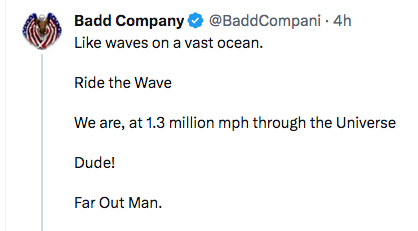
#eddies#eddies in the space-time continuum#well tell him to get out#it is worth noting that one of my main impressions from a series of investigative shroom journeys was seeing a sort of 3d grid#the grid was my mind trying to visualize the waves surrounding thing and the grid kinda worked. Next dimension visualization.
15 notes
·
View notes
Text
i suppose you guys will start hearing about this sometime next year, but there have been over 200 candidate gravitational wave observations since the start of ligo o4. the total from the first 3 operating runs (mostly o3) was like 90, so this triples the size of the stellar graveyard and it's only been a few short weeks. this isn't, i imagine, a well-kept secret on purpose -- everybody who's anybody in the field is probably being run ragged by the sheer volume of research they now have to pursue, and it's left to me, nobody, to tell you that something is going on. (this is also COMPLETELY separate from the gw background detection using pulsar timing arrays, a thing i am thrilled to have been able to premonish years in advance and have been meaning to write about, which had no affiliation with ligo)
i suppose it would have been headlining news if any of these were coincident with observations in the optical spectrum (and this is also fairly easy for me to determine, but i haven't checked religiously). i've already covered why these events are biased to the earlier universe and do not often appear locally. the nearest one (the 2017 nobel prize kilonova, although iirc there was another, possibly nearer event with no optical counterpart) was 120mly away, approximately the entire width of the filament on which our galaxy's supercluster resides. i have not gotten a clear answer whether it was on the same filament lengthwise (this is probably an easy question for better astronomers than me, who can read a map and know offhand what structure a region of sky contains). that does seem likeliest, since the voids between filaments appear to be larger than the filaments themselves. the vast majority of these events are faint ripples from other filaments, probably too distant to even catalogue the galaxies they contain
anyway the HCB wall (largest theorized superstructure) was based on a dataset of like, 20 gamma ray bursts. so, when you start hearing about this, it's probably going to be in the form of a significant revision to our concept of superstructure
this is slightly complicated by the fact that grbs are pointlike sources and gwes are a hideously vague smear of probability across the sky -- but if they appear to be biased toward a certain area, like the trans neptunian objects, then we'll never stop hearing about it, much like the apocryphal trans neptunian planet nine
7 notes
·
View notes
Text
Yall keep an eye out for the Pulsar Timing Array announcement set to come out tomorrow. For context the project studies gravitational waves using pulsars - dead stars that have extremely regular emissions - to detect fluctuations caused by these gravitational waves. This will likely have something to do with the gravitational wave background, which is a similar concept to the cosmic microwave background. The CMB is at a specific point in time of the universe, and the hope is that mapping out background gravitational waves will give scientists a look to even further back in time.
#physics studyblr#ramblings#I'm so excited for this#it might not be as big as im hoping but it should at least show some good progress towards this background stuff
7 notes
·
View notes
Text

A series of articles published or being published in the journals "Astronomy and Astrophysics" and "The Astrophysical Journal Letters" reports various aspects of the detection of very low-frequency gravitational waves. Researchers from the European Pulsar Timing Array (EPTA), the Indian Pulsar Timing Array (InPta), the Parkes Pulsar Timing Array (PPTA), the Chinese Pulsar Timing Array (CPTA), and the North American Nanohertz Observatory for Gravitational Waves (NanoGrav) analyzed data collected over the course of more than 25 years using groups of pulsars to obtain a kind of detector of gravitational waves at the galactic level. This was possible by exploiting the extreme regularity of the signals emitted by pulsars to detect variations of less than a millionth of a second and their correlations to identify gravitational waves. This technique expands the gravitational-wave astronomy opened up by the LIGO and Virgo detectors since the announcement of the first detection in February 2016.
2 notes
·
View notes